Ratary shaft seal (simmering)
Rotary shaft seal (or simmering), are one of the most popular rotary seals used for radial shaft sealing. They are made of rubber and braced with a metal insert or encased in a sheet metal cover. They can operate in lubricant, oil, fuel or water at pressures up to 0.1 MPa in a temperature range from -30 to +260 °C. A cylindrical outer surface of steel or elastomer seals the ring statically in the seat.
Simmering rings have an elastomer sealing lip pressed radially towards the shaft surface; some variants have a dustproof lip to protect against dust and other solid contaminants. Sealing rings have a wide variety of designs and are made from various materials that guarantee their reliability under various operating conditions.
Thanks to their FDA approval, they can be used in the food and pharmaceutical industries.
Advantages:
high chemical resistance
High temperature resistance
simplest way of sealing a shaft various dimensions
versatility and variety of applications
FDA approval possible
Principal use:
shaft seals in a wide variety of process equipment in the chemical, food, automotive, petrochemical industries, sewage treatment plants, white goods, etc.
The following types of simmering are specified:
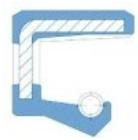

Rotary shaft seal Type A:
It has a standard design without a dust lip and consists of:
an elastomeric outer shell
metal sealing insert
a self-sealing ring reinforced with a compression spring.
Compression spring:
with material NBR- non-alloy spring steel to DIN EN 10270-1
with material FPM- acid resistant stainless steel 1.4301
Features:
NBR operating temperature range: from -40 °C to +100 °C / NBR speed: < 12 m/s
FPM operating temperature range: -30 °C to +200 °C / FPM rotational speed: < 35 m/s
Pressure NBR, FPM: < 0.05 MPa
Application:
Wide range of applications in all industries.
Sealing of parts of equipment moving in rotary or torsional motion such as shafts, hubs and axles.
Rotary shaft seal Type AO:
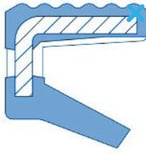

It has a design without a dust lip and consists of:
an elastomeric outer shell with an additional dust lip
metal sealing insert
a self-sealing ring reinforced with a compression spring
Features:
NBR operating temperature range: from -40 °C to +100 °C / NBR speed: < 12 m/s
FPM operating temperature range: -30 °C to +200 °C / FPM speed: < 35 m/s
Pressure NBR, FPM: non-pressurised
Application:
Subordinate seals used, e.g. as a protective seal against dust,
dirt or splashing in electric motors, or as a seal against grease leakage
Ratary shaft seal Type AS:
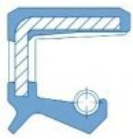

It has a dust lip design and consists of:
an elastomeric outer shell
metal sealing insert
elastomeric self-sealing ring.
Used as an auxiliary seal for water and dust operating without pressure.
Compression spring:
with material NBR- non-alloy spring steel to DIN EN 10270-1
with material FPM- acid resistant stainless steel 1.4301
Features:
NBR operating temperature range: from -40 °C to +100 °C / NBR speed: < 12 m/s
FPM operating temperature range: -30 °C to +200 °C / FPM rotational speed: < 35 m/s
Pressure NBR, FPM: 0.05 MPa
Application:
Wide range of applications in all industries.
Sealing of parts of equipment moving in rotary or torsional motion such as shafts, hubs and axles.
Rotary shaft seal Type ASY:
It has a design without a dust lip and consists of:
an elastomeric outer shell
a metal sealing insert: non-alloy steel to DIN EN 10270-1
a self-sealing ring reinforced with a compression spring.
Compression spring
with material NBR- unalloyed spring steel to DIN EN 10270-1
with material FPM- acid resistant stainless steel 1.4301
Features:
NBR operating temperature range: from -40 °C to +100 °C / NBR speed: < 10 m/s
FPM operating temperature range: -30 °C to +170 °C / FPM rotational speed: < 35 m/s
Pressure NBR, FPM: 1 MPa
Application:
Wide range of applications in all industries.
Sealing of rotating or torsionally moving equipment parts such as shafts, hubs and axles.
Application examples: Power transmission systems (e.g. gears), engineering, electric motors.
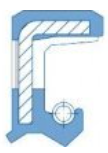

Rotary shaft seal Type B:
It has a design without a dust lip and consists of:
a metal outer casing: Non-alloy steel to DIN EN 10270-1. The metal casing ensures particularly strong and accurate seating. It effectively dissipates heat from the sealing space.
Self-sealing ring reinforced with compression spring.
Compression spring:
with NBR material - unalloyed spring steel to DIN EN 10270-1
Features:
NBR operating temperature range: -40 °C to +100 °C / NBR speed: < 12 m/s
Pressure NBR, FPM: 0.05 MPa
Application:
Wide range of applications in various industries.
resistant to mineral oils and greases
resistant to vegetable and animal oils
resistant to aliphatic hydrocarbons
resistant to non-flammable hydraulic fluids: HSA and HSB
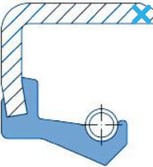

Rotary shaft seal Type BO:
It has a design without a dust lip and consists of:
a metal outer casing: Non-alloy steel to DIN EN 10270-1. The metal casing ensures particularly strong and accurate seating. It effectively dissipates heat from the sealing space.
self-sealing ring without pressure spring
Compression spring:
none
Features:
NBR operating temperature range: -40 °C to +100 °C / NBR speed: < 6 m/s
NBR pressure: non-pressurised
Application:
Wide range of applications in various industries.
resistant to mineral oils and greases
resistant to vegetable and animal oils
resistant to aliphatic hydrocarbons
resistant to non-flammable hydraulic fluids: HSA and HSB
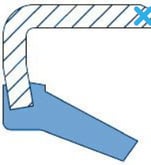

Rotary shaft seal Type BS:
It has a design with a dust lip and consists of:
a metal outer casing: Non-alloy steel to DIN EN 10270-1. The metal casing ensures particularly strong and precise seating. It effectively dissipates heat from the sealing space.
compression spring reinforced self-sealing ring.
Compression spring:
with NBR material - unalloyed spring steel to DIN EN 10270-1
Features:
NBR operating temperature range: -40 °C to +100 °C / NBR speed: < 12 m/s
NBR pressure: 0.05 MPa
Application:
Wide range of applications in various industries.
resistant to mineral oils and greases
resistant to vegetable and animal oils
resistant to aliphatic hydrocarbons
resistant to non-flammable hydraulic fluids: HSA and HSB
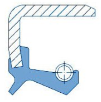

Rotary shaft seal Type C:


It has a design without a dust lip and consists of:
metal outer shell: Non-alloy steel to DIN EN 10270-1. The metal reinforced casing ensures particularly strong and accurate seating. It effectively dissipates heat from the sealing space.
compression spring reinforced self-sealing ring.
Compression spring:
with NBR material - unalloyed spring steel to DIN EN 10270-1
Features:
NBR operating temperature range: -40 °C to +100 °C / NBR speed: < 12 m/s
NBR pressure: 0.05 MPa
Application:
Wide range of applications in various industries.
resistant to mineral oils and greases
resistant to vegetable and animal oils
resistant to aliphatic hydrocarbons
resistant to non-flammable hydraulic fluids: HSA and HSB
Rotary shaft seal Type CS:
It has a design with a dust lip and consists of:
metal outer shell: Non-alloy steel to DIN EN 10270-1. The metal reinforced casing ensures particularly strong and accurate seating.
It effectively dissipates heat from the sealing space.
self-sealing ring reinforced with compression spring.
Compression spring:
with NBR material - unalloyed spring steel to DIN EN 10270-1
Features:
NBR operating temperature range: -40 °C to +100 °C / NBR speed: < 12 m/s
NBR pressure: 0.05 MPa
Application:
Wide range of applications in various industries.
resistant to mineral oils and greases
resistant to vegetable and animal oils
resistant to aliphatic hydrocarbons
resistant to non-flammable hydraulic fluids: HSA and HSB


Classification of simmering devices by design solution:


Simmering Type BA:
Standard construction according with DIN 3760 type A.
Rubber-covered outer surface.
Can be used in housing with rough thermal surface. Provides leak-tightness under positive pressure and vacuum and leak-tightness in split housings and light metal housings. Permissible pressure up to 0.05 MPa.
Simmering Type B1:
Standard design with open outer metal housing for simple assembly. Type B according to DIN 3760. Used when high pressures occur, pushing the seal out of the socket. Allowable pressure up to 0.05 MPa.


Simmering Type B2:


Standard construction with reinforced outer metal housing for normal mounting. Type C to DIN 3760, usually in large sizes. Application as B1.
Simmering Type BASL:


Standard type BA with additional dust lip (SL) against moderate to medium external dirt. Type AS to DIN 3760.
Simmering Type B1SL:


Standard type B1 with additional dust lip (SL) against moderate to medium external dirt. Type BS according to DIN 3760.
Simmering Type B2SL:


Standard type B2 with additional dust lip (SL) against moderate to medium external contamination. Type CS according to DIN 3760.
Simmering Type B1BA:


A solution that combines the characteristics of BA and B1 type seals.
Simmering Type B1BASL:


A solution that combines the characteristics of BASL and B1SL type seals.
Simmering Type BAB:


Pressure sealing solution for very narrow seals. Resistant to pressures above 0.05 MPa.
Simmering Type BABSL:


Pressure sealing with additional dust lip against external dust. Version used for very narrow sealing.
Simmering Type BAD:


It has the characteristics of a BA sealing compound but is suitable for pressure seals up to 1.5 bar.
Simmering Type B1D:


It has the characteristics of a B1 sealing compound but is suitable for pressure seals up to 1.5 bar.
Simmering Type BADUO:


It has the characteristics of a BA sealing but is a two-sided seal.
Simmering Type B1DUO:


It has the characteristics of a B1 sealing but is a two-sided seal.
Simmering Type BAOF:


Design solution without spring. For sealing with solid grease lubricants.
Simmering Type B1OF:


Design solution without spring. For sealing with solid grease lubricants.
Simmering Type COMBI:


Integrated seal for high dust exposure, mainly for axle seals on farm tractors and construction machinery. High resistance to external contamination.
Simmering Type RWDR-KASSETTE:


A complete seal consisting of a right-side simmering and integrated raceway and a labyrinth system to prevent contaminants from reaching the righ-side seal. Typically used on construction and agricultural machinery operating under highly contaminated conditions. Possible variants of this seal: ...RS... - left-hand reject ...RD... - right-hand reject ...DRW... - double-acting reject ...X6...- multiplied dust lip ...X7...- additional outer seal
Simmeringi TURCON® VARILIP® PDR dla przemysłu spożywczego, chemicznego firmy TRELLEBORG:


Turcon® Varilip® PDR is a seal used where elastomeric seals are unable to provide the required seal.
It is a seal made of metal and a PTFE lip. The PTFE material allows it to be used over a wide operating temperature range from -100ºC to + 260ºC while maintaining excellent chemical resistance.
Turcon® Varilip® PDR has a low coefficient of friction and no stick-slip phenomenon, as well as reducing temperature generation and allowing higher surface speeds.
TECHNICAL DATA:
Operating pressure: 1 MPa
Speed: 60 m/s
Temperature: -100°C to +260°C
Symbol: TJA Symbol: TJB Symbol: TJC Symbol: TJD Symbol: TJG
Simmeringi PS-SEAL® GARLOCK company:


PS-SEAL® Standard is a Garlock shaft seal consisting of a stainless steel housing, a GYLON® BLACK lip seal and a static sealing element made of FKM.
Technical specifications:
operating temperature: max. 205°C
operating pressure: up to 10 bar
Simmering Type PS-SEAL® Standard:




Dimensions and build-up:
Simmering Typ PS-SEAL® Non-Standard:
Garlock's PS-SEAL® Non-Standard is a standard-sized product, but with a different lip seal configuration and made of different materials:
Reverselip, Single + Dustlip
Tandem Back-to-Back
Other lip materials and modification of inner diameter and width
Technical specifications:
operating temperature: max. 205°C
working pressure: up to 25 bar (depending on diameter and type)


Dimensions and build-up:


Simmering Typ PS-SEAL® Special:


PS-SEAL® Special, due to the different applications for high-parameter seals, are available as kit options with single or multiple lips. These seals are standardised to provide cost-effective special solutions. PS-SEAL® Special is available in a wide variety of material configurations that enable their use in virtually all industries including food and pharmaceuticals.
Technical specifications
operating temperature: max. 205°C
working pressure: up to 25 bar (depending on diameter and type)
Dimensions and build-up:
Sealing lip materials for Simmerings Type PS-SEAL®:
PS-SEAL® Simmering can be available with a variety of sealing lip materials that enable them to be used in all industries, including the food and pharmaceutical industries.
Possible sealing lip materials and their applications.


Mounting Dimensions
Mounting Dimensions
Mounting Dimensions
Mounting Dimensions
Gasket materials for the food and pharmaceutical industries:
Acrylonitrile butadiene rubber (designation NBR) - the most common material used for these types of seals. It can operate at temperatures from -30°C to +100°C. It is characterised by resistance to oils, greases and fuels.
Fluorocarbon rubber (designation FPM-Viton) - the operating temperature of this material is from -20°C to +200°C. It is resistant to mineral oils and greases, HSC hydraulic fluids, but also ultraviolet radiation, ozone. This type of rubber is also characterised by excellent resistance to ageing.
Silicone rubber (designated VMQ silicone) - a material resistant to temperatures from -60°C to +200°C, and briefly up to +230°C. It is highly resistant to alcohols, water up to +100°C, oils and mineral lubricants. Very often used in the food industry.
EPDM (Ethylene-Propylene-Dien-Monomer rubber) - rubber resistant to temperatures from -40°C to +115°C. Characterised by very good resistance to ozone, steam and light acids and bases, as well as glycols. Very often used in the food industry.
Teflon (PTFE designation) - resistant to most chemical media, characterised by a wide operating temperature range, from -100°C to +250°C. Very often used in the food industry and f) - resistant to most chemical media, characterised by a large operating temperature range, from -100°C to +250°C. Very often used in the food and pharmaceutical industries.
GYLON (designation GYLON® White, GYLON® Blue, GYLON® Brown-White) - resistant to most chemical media, characterised by a wide operating temperature range from -100°C to +205°C. Very often used in the food and pharmaceutical industries.
GYLON® White - used in the food (e.g. dairy, beverage) and pharmaceutical, cosmetic, chemical and plastics industries. Resistant during CIP and SIP processes. Suitable for shaft speeds up to 2 m/s and operating pressures up to 2 bar. Operating temperature up to 40°C.
GYLON® Blue - used in the food industry (e.g. mixing processes, grinding in meat processing, dairy, beverage, fish processing, confectionery) and the pharmaceutical and cosmetics industries. Resistant in operation during CIP and SIP processes. Can be used at shaft speeds from 30 rpm to 2,700 rpm and operating pressures from -1 bar to 3 bar. Operating temperature up to 180°C. The operating parameters are determined by the seal type, shaft diameter and installation parameters as well as the application used.
Gasket materials for the chemical industry and other industries (wood, tyre, water and waste management):
Acrylonitrile butadiene rubber (designation NBR) - the most common material used for these types of seals. It can operate at temperatures from -30°C to +100°C. It is characterised by resistance to oils, greases and fuels.
Fluorocarbon rubber (designation FPM) - the operating temperature of this material is -20°C to +200°C. It is resistant to mineral oils and greases, HSC hydraulic fluids, but also ultraviolet radiation, ozone. This type of rubber is also characterised by excellent resistance to ageing.
Silicone rubber (designated VMQ silicone) - a material resistant to temperatures from -60°C to +200°C, and briefly up to +230°C. It is highly resistant to alcohols, water up to +100°C, oils, as well as mineral lubricants.
Polyacrylic rubber (designation ACM) - rubber resistant to temperatures from -25°C to +150°C.
Teflon (PTFE designation) - resistant to most chemical media and has a wide operating temperature range, from -100°C to +250°C.
Certificates and material approvals (Elastomers):
FDA 21. CFR 177.2600
FDA 21. CFR 177.2400
EG/EC 1935/2004
EC 2023/206
USP class VI to +121 °C <88>
EU 2011/65/EU (ROHS)
EU 1907/2006 (REACH)
ADI-Free
Certificates and material approvals (Termoplastics):
FDA 21. CFR 177.1550
EG/EC 1935/2004, EU 10/2011
USP class VI to +121 °C <88>
EU 2011/65/EU (ROHS)
EU 1907/2006 (REACH)
EU 2023/2006 (GMP)
TA-Luft
ADI-Free
